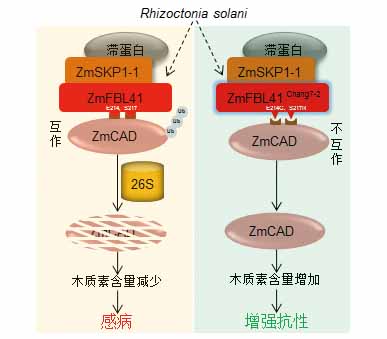

Discovery of ZmFBL41 Chang7-2 as A Key Weapon against Banded Leaf and Sheath Blight Resistance in Maize
Received date: 2019-08-27
Accepted date: 2019-09-17
Online published: 2019-09-30
The fungal pathogen Rhizoctonia solani causes banded leaf and sheath blight (BLSB) in maize (Zea mays) and sheath blight (ShB) in rice (Oryza sativa). R. solani has a wide range of host and severely threatens crop production. The lack of resistant resources against BLSB and the poor understanding of disease resistance mechanism hamper the development of effective approaches to control this fungal disease. Recently, Chinese scientists have made a breakthrough discovery that an F-box protein ZmFBL41 mediates the proteasomal degradation of cinnamyl-alcohol dehydrogenase ZmCAD to regulate BLSB and ShB disease resistance. By genome-wide association analysis, GRMZM2G 109140 (ZmFBL41) was identified as a major QTL candidate gene associated with BLSB disease resistance. ZmFBL41 protein is a member of SKP1-Cullin-F-box (SCF) E3 ubiquitin ligase complex which mediates the degradation of ZmCAD, thus reducing the accumulation of lignin and rendering maize more susceptible to R. solani. Interestingly, in the maize inbred line Chang7-2, the natural variation on two amino acids in ZmFBL41 Chang7-2 results in resistance against BLSB. Mechanistically, ZmFBL41 Chang7-2 fails to interact with and degrade its substrate ZmCAD, leading to the accumulation of lignin, which consequently enhances maize resistance. This study not only discovers a novel molecular mechanism underlying disease resistance of maize against R. solani, but also provides important theoretical basis and genetic resources for breeding maize and other crops with improved disease resistance.

Key words: plant immunity; SKP1-Cullin-F-box; lignin; banded leaf and sheath blight; maize; rice
Weitao Li , Min He , Xuewei Chen . Discovery of ZmFBL41 Chang7-2 as A Key Weapon against Banded Leaf and Sheath Blight Resistance in Maize[J]. Chinese Bulletin of Botany, 2019 , 54(5) : 547 -549 . DOI: 10.11983/CBB19166
| 1 | Baruah P, Lal S (1981). Hostrange of Rhizoctonia solani f. sp. sasakii, then incitant of banded sclerotial disease of maize. Indian Phytopath 34, 494-496. |
| 2 | Hooda KS, Khokhar MK, Parmar H, Gogoi R, Joshi D, Sharma SS, Yadav OP (2017). Banded leaf and sheath blight of maize: historical perspectives, current status and future directions. Proc Natl Acad Sci India Sect B Biol Sci 87, 1041-1052. |
| 3 | Li N, Lin B, Wang H, Li X, Yang F, Ding X, Yan J, Chu Z (2019). Natural variation in ZmFBL41 confers banded leaf and sheath blight resistance in maize. Nat Genet 51, 1540-1548. |
| 4 | Li Z, Pinson SRM, Marchetti MA, Stansel JW, Park WD (1995). Characterization of quantitative trait loci (QTLs) in cultivated rice contributing to field resistance to sheath blight ( Rhizoctonia solani). Theor Appl Genet 91, 382-388. |
| 5 | Maeda S, Dubouzet JG, Kondou Y, Jikumaru Y, Seo S, Oda K, Matsui M, Hirochika H, Mori M (2019) The rice CYP78A gene BSR2 confers resistance to Rhizoctonia solani and affects seed size and growth in Arabidopsis and rice. Sci Rep 9, 587. |
| 6 | Ogoshi A (1987). Ecology and pathogenicity of anastomosis and interspecific groups of Rhizoctonia solani Kuhn. Ann Rev Phytopathol 25, 125-143. |
| 7 | Peng X, Wang H, Jang JC, Xiao T, He H, Jiang D, Tang X (2016). OsWRKY80-OsWRKY4 module as a positive regulatory circuit in rice resistance against Rhizoctonia solani. Rice 9, 63. |
| 8 | Richa K, Tiwari IM, Devanna BN, Botella JR, Sharma V, Sharma TR (2017). Novel chitinase gene LOC_Os 11g47510 from indica rice Tetep provides enhanced resistance against sheath blight pathogen Rhizoctonia solani in rice. Front Plant Sci 8, 596. |
| 9 | Sharma RC, Srinivas P, Batsa BK (2002). Banded leaf and sheath blight of maize its epidemiology and management. In: Rajbhandari NP, Ransom JK, Adhikari K, Palmer AFE, eds. Proceedings of a Maize Symposium Held. Kathmandu: NARC and CIMMYT. pp. 108-112. |
| 10 | Sharma RR, Gour HN, Rathore RS (2004). Etiology of banded leaf and sheath blight symptoms on maize. J Mycol Plant Pathol 34, 56-59. |
| 11 | Singh BM, Sharma YR (1976). Evaluation of maize germplasm to banded sclerotial disease and assessment of yield loss. Indian Phytopath 29, 129-132. |
| 12 | Wang H, Meng J, Peng X, Tang X, Zhou P, Xiang J, Deng X (2015). Rice WRKY4 acts as a transcriptional activator mediating defense responses toward Rhizoctonia solani, the causing agent of rice sheath blight. Plant Mol Biol 89, 157-171. |
/
| 〈 |
|
〉 |